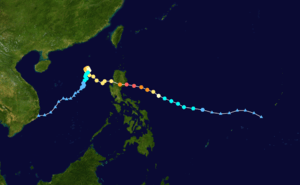Li's field



Li's Field (Chinese: 李氏力場, also known as Li's force field or K.S. Field) is a tongue-in-cheek conspiracy theory in Hong Kong over the existence of a force field that repels tropical cyclones from the city.
Background
The "Li" in Li's Field refers to local business tycoon Li Ka-shing, the implied developer of the field. The basis of Li's Field rests on the way Hong Kong's government is organized. The city's Commerce and Economic Development Bureau oversees the Hong Kong Observatory,[1]and that has led to speculations the Observatory bases its issuance of tropical cyclone warning signals on economic reasoning, instead of scientific reasoning.
In Hong Kong, schools above kindergarten level are shut down when Tropical Cyclone Signal Number 8 is issued (kindergarten classes are suspended when Signal Number 3 is issued),[2] and all non-essential staff at a workplace are sent home.[3] Some believe businesses have pressured the Observatory into avoiding the issuance of Typhoon Signal Number 8, in an effort to avoid economic losses.
Examples
From 2005 to 2006, and once again in 2010, the Observatory did not issue a single tropical cyclone warning above Number 3.[4]
Typhoon Prapiroon
In 2006, Typhoon Prapiroon brought 200km/h wind to Hong Kong,[5] overturned containers, uprooted trees, and caused many flight delays at the airport,[6] but the Observatory did not issue Signal Number 8, remaining at the lower level Signal Number 3.[7]
Observatory Chief Lam Chiu-ying later said the decision was based on the fact that wind speeds in Kai Tak, near the Victoria Harbour, did not reach the level required for issuing Signal Number 8.[5] Nevertheless, humorous speculation arose that Li Ka-shing was behind the decision, in an effort to maximize productivity from his workers and prop up the economy.
Scientific reason
Media reports in 2010, citing research by the Observatory, revealed the reason behind the fewer occurrences of Signal Number 8. It is believed that an ocean temperature difference between the South China Sea and the Pacific Ocean is to blame.[8]

Reaction From The Observatory
Former Observatory Chief Lee Boon Ying told reporters in 2010 the Observatory has always put the safety of Hong Kong residents as its first priority, and is not swayed by business or economic concerns.[9]
Survey
In an impromptu survey conducted by Observatory Chief Shun Chi Ming at a student forum in 2014, about 20% of approximately 100 students in attendance say they believe Li's Field exists.[10]
Cultural references
Li's force field has been mentioned in local cultural media, and has been the subject of many Internet memes.[11]
See also
References
- ↑ "Commerce and Economic Development Bureau - Home". Commerce and Economic Development Bureau of the Hong Kong Special Administrative Region. Retrieved 2 August 2014.
In addition to the above policy responsibilities, our Bureau also oversees the operation of ten executive arms, namely the Invest Hong Kong, Intellectual Property Department, Trade and Industry Department, Hong Kong Observatory, Post Office, Innovation and Technology Commission, Office of the Government Chief Information Officer, Office for Film, Newspaper and Article Administration, Radio Television Hong Kong, Office of the Communications Authority, and the overseas Hong Kong Economic and Trade Offices.
- ↑ "EDUCATION BUREAU CIRCULAR NO. 12/2013 Tropical Cyclones and Heavy Persistent Rain Arrangements for Kindergartens and Day Schools" (PDF). Government of the HKSAR Education Bureau. 5 July 2013. Retrieved 2 August 2014.
- ↑ "Code of Practice in times of Typhoons and Rainstorms" (PDF). Labour Department. Hong Kong Special Administrative Region Labour Department. p. 21. Retrieved 2 August 2014.
- ↑ "Frequency and Total Duration of Display of Tropical Cyclone Warning Signals :1956 - 2013". Hong Kong Observatory. Retrieved 2 August 2014.
- 1 2 Cheung, Tony (21 October 2013). "How ex-Observatory chief Lam Chiu-ying has become an unlikely scourge of the establishment". South China Morning Post (via Newslookup.com). Retrieved 2 August 2014.
- ↑ Cheung, Chi-fai (13 October 2006). "Revamp of typhoon warnings considered". South China Morning Post. South China Morning Post Publishers Ltd. Retrieved 2 August 2014.
- ↑ "Tropical Cyclone Warning Signals For Prapiroon". HKO Warnings and Signals Database. Hong Kong Observatory. Retrieved 3 August 2014.
- ↑ "南海中層高氣壓 擋襲港颱風 (A High Pressure Zone Above the South China Sea Is Blocking Hong Kong-bound Typhoons)". Ming Pao. 23 October 2010. Retrieved 2 August 2014.
- ↑ "天文台指掛波不涉經濟 強調市民安全最重要 (The Observatory Says Economy Takes No Part In Issuing Cyclone Warnings, Stress Citizen Safety As The Top Priority)". AM730 (in Chinese) (AM730 Media Limited). 26 October 2010. Retrieved 3 August 2014.
- ↑ "學生信有「李氏力場」 (Students Believe In "Li's Field")" (in Chinese). Apple Daily. 11 May 2014. Retrieved 2 August 2014.
- ↑ Metro - Metro in 18 years (Page 2, bottom left
External links
- Li's Field on Encyclopedia of Virtual Communities in Hong Kong (Traditional Chinese)
- Li's Field's "Record" on Encyclopedia of Virtual Communities in Hong Kong (Traditional Chinese)